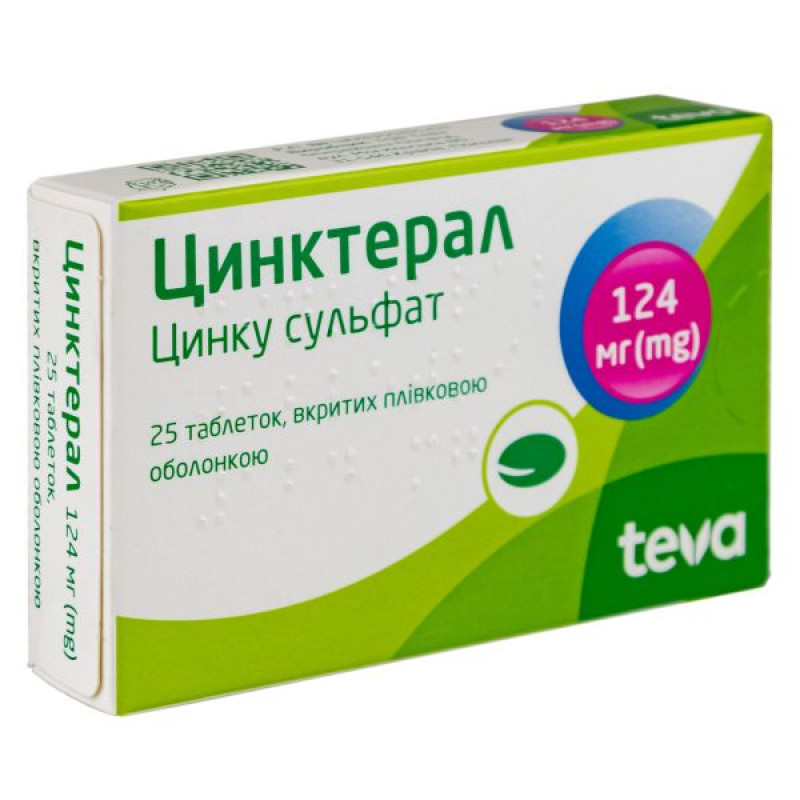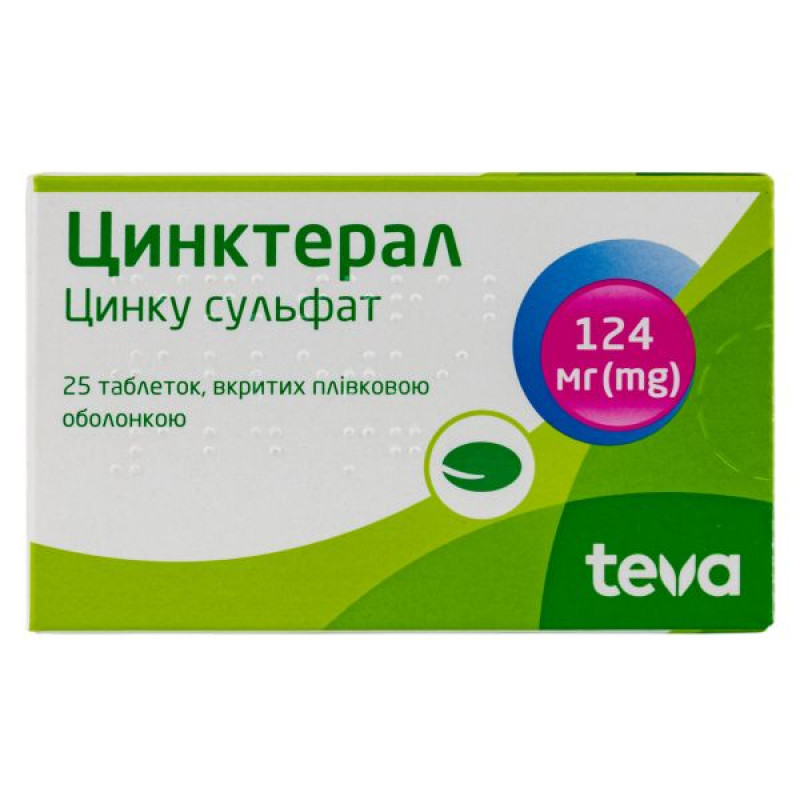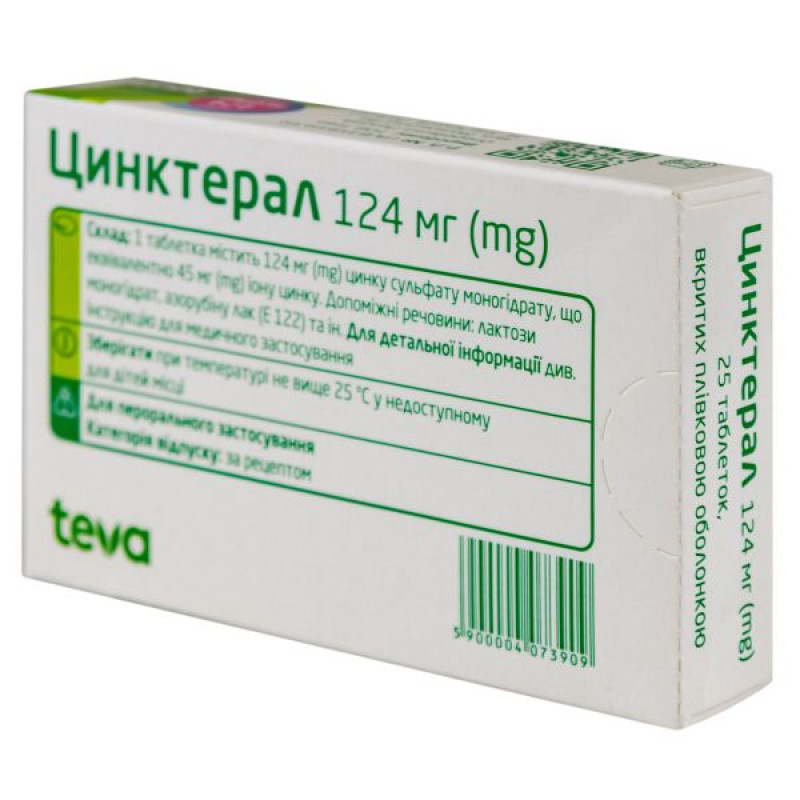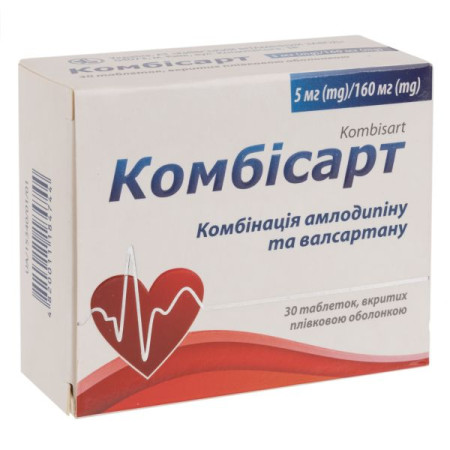Cinquetal film-coated tablets 124 mg No. 25

Pharmacological properties
Pharmacodynamics. Zinc is one of the most important trace elements that are part of many enzyme systems that regulate the basic metabolic processes, namely: it participates in protein synthesis and carbohydrate metabolism. Zinc is necessary for the functioning of more than 200 metalloenzymes (for example, carbonic anhydrase, carboxypeptidase a, alcohol dehydrogenase, LF, RNA polymerase, etc.), as well as for maintaining the normal structure of nucleic acids, proteins and cell membranes. Zinc contributes to the growth and development of cells, the proper functioning of the immune system and ensuring the immunological response, twilight vision, taste sensations and smell perception. It affects the maintenance of normal levels of vitamin a in the blood, prolongs the action of insulin and facilitates its accumulation. In inflammatory skin conditions, it has a preventive and therapeutic effect.
Pharmacokinetics. Regardless of the zinc content in food, about 20-30% of the ingested zinc is absorbed in the duodenum and small intestine. The maximum concentration of zinc in the blood plasma is reached 2 hours after taking the drug. In the body, zinc accumulates mainly in leukocytes and erythrocytes, as well as in muscles, bones, skin, kidneys, liver, pancreas, retina. 60% of zinc binds to albumins, 30-40% to α 2 -macroglobulin, 1% to amino acids, mainly to histidine and cysteine. Zinc is excreted from the body mainly with feces (90%), to a lesser extent - with urine and sweat.
Indication
Treatment of zinc deficiency caused by malnutrition, impaired absorption of the trace element, assimilation or increased loss by the body, which is observed in the following conditions: alcoholism, burns, cirrhosis of the liver, diabetes mellitus, anorexia, bulimia, conditions after gastrectomy, genetic diseases (Down syndrome, enteropathic acrodermatitis, sickle cell anemia, thalassemia), hemodialysis, chronic infections caused by reduced reactivity of the immune system, parasitic invasions of the intestine, pancreatic insufficiency, cystic fibrosis of the pancreas, kidney diseases (nephrotic syndrome, renal failure), intestinal diseases (celiac disease, Crohn's disease, steatorrhea, ulcerative colitis), short bowel syndrome, skin diseases (exfoliative dermatitis, psoriasis), prolonged stress, injuries, diets.
Application
The drug is prescribed orally to adults and children over 4 years of age. It is usually taken 1 hour before or 2 hours after a meal, since many foods impair the absorption of zinc. If symptoms of irritation from the gastrointestinal tract occur, the drug can be taken with food, but in this case its bioavailability may decrease.
Adults are prescribed 1-2 tablets per day. Children over 4 years of age and adolescents are prescribed 1 tablet per day.
The duration of the treatment course is determined by the doctor individually, depending on the degree of clinically proven zinc deficiency and the achieved therapeutic effect.
Contraindication
Hypersensitivity to the components of the drug.
Side effects
Sometimes there may be gastrointestinal disorders (nausea, dyspepsia, heartburn); hematological disorders due to copper deficiency, including leukopenia (fever, chills, sore throat), neutropenia (mouth and throat ulcers), sideroblastic anemia (feeling of fatigue, weakness); headache and metallic taste in the mouth.
Special instructions
When using preparations containing zinc, it is necessary to take into account the risk of copper deficiency. When following a diet rich in fibrin (e.g. bran), phosphates (e.g. dairy products), whole-grain bakery products and phytinates, zinc absorption is reduced due to the formation of complexes. The interval between the use of the above-mentioned products and taking zinc preparations should be at least 2 hours.
Pregnancy and breastfeeding.
Zinc crosses the placental barrier and is excreted in breast milk. During pregnancy, the drug is used only in cases where, in the opinion of the doctor, the benefit to the mother outweighs the potential risk to the fetus. It is necessary to prescribe the drug with caution during breastfeeding.
Children. The drug is used in children over 4 years of age.
The ability to influence the reaction speed when driving or working with other mechanisms.
Zinc salts do not affect the reaction rate.
Interactions
Zincteral reduces the absorption of tetracycline and inhibits the absorption of copper (when using zinc in high doses), so it should be taken no earlier than 2 hours after taking these drugs.
Thiazides increase the urinary excretion of zinc.
Folic acid slightly impairs zinc absorption.
Oral administration of high doses of iron, penicillamine and other chelating agents reduces zinc absorption. The interval between the use of these drugs and zinc salts should be at least 2 hours.
When using multivitamin preparations with minerals containing zinc simultaneously with Zincteral, the possibility of overdose must be taken into account.
The following may occur: burning in the mouth and throat, watery or bloody diarrhea, painful urge to defecate, belching, hypotension (dizziness), jaundice, pulmonary edema (chest pain, difficulty breathing), vomiting, hematuria, anuria, collapse, convulsions, hemolysis.
If the above symptoms occur, you should drink milk or water, and then inject IM or IV disodium salt of ethylenediaminetetraacetic acid at a dose of 50-75 mg/kg body weight per day in 3-6 injections for no more than 5 days.
Storage conditions
At a temperature of 15-25 °C.
There are no reviews for this product.
There are no reviews for this product, be the first to leave your review.
No questions about this product, be the first and ask your question.















